
 |
||||||
|
GAY
FILM REVIEWS BY MICHAEL D. KLEMM
|
||||||
|
Cruising Warner
Brothers Home Video,
Director/ Screenplay: Starring: Rated R, 102 minutes
|
The
Return Of Cruising
It's baaaack! Newly restored for its debut on DVD, it's time to revisit William Friedkin's Cruising (1980) - a movie with lots of baggage that still manages to polarize the gay community to this day. Is it really as bad as its reputation makes it out to be? Do a Google search and you will find opinions from all over the spectrum. The old guard has mellowed somewhat but, for the most part, still views it as an abomination, and younger writers are calling us a bunch of old farts as they wonder what all the fuss was about. I am going to assume that most of my readers have seen the film and, if not, are at least familiar with it. For those who haven't, there are spoilers ahead. THE
CONTROVERSY |
|
It is well known that there was intense protesting during the filming. Vito Russo was one of the demonstrators and gives a full report in The Celluloid Closet. Queers were angry about this movie. It might have been different if positive portrayals of gay men and lesbians existed on the Hollywood screen or on television at this time but this was 1979. |
|
|
All we wanted was some balance. One protester wrote, perhaps melodramatically, that "People will die because of this film." Another famously wrote that "Cruising wasn't a film about how we live, it was a film about how we should be killed." Demonstrators did everything they could to sabotage the filming. There was an unsuccessful attempt to get Friedkin's location permits in the Village revoked. When that didn't work, people honked horns and blasted stereos out of windows to interfere with the sound recording. Others sat on rooftops with large reflectors to disrupt the lighting. Regulars of the meat packing district's leather bars participated in the filming but several of the bars backed out when they saw the script. |
|
 |
|
|
The naysayers weren't wrong. Gay bashings did go up after Cruising hit the movie theaters in 1980. Screenwriter Ron Nyswaner, (Philadelphia, Soldier's Girl), reports in the HBO film of The Celluloid Closet that he and his boyfriend narrowly escaped being beaten by a group of college jocks who had just seen Cruising and told them that this was what they deserved. My partner, Andy, counseled gays at the college where he taught, and he got panicky calls from many young men asking if that is going to be what their lives would be - wondering if they would be killed or wind up as someone's bitch. Remember too that the S&M world is a lot more accepted and recognized now than it was then by gays and straights alike. FANNING
THE FLAMES FURTHER: |
|
|
Speaking of The Exorcist, there is a rather creepy connection between it and Cruising that is revealed in the extras (and was reported in The Celluloid Closet as well). A hospital technician who appeared in one of the lab scenes of The Exorcist committed a series of gay murders a few years later. Friedkin's interview with the man in prison inspired him to make Cruising.
Friedkin must have "got" the protests to some extent because he inserted the line of dialogue about the S&M scene not being "the mainstream of gay life" and that it was "a world onto itself." For this, he is to be commended. He also inserted a disclaimer at the beginning of the film that stated that this was not meant to represent all gay life (this disclaimer, however, is curiously missing on the new DVD. Hmm....). Vito Russo called the disclaimer an "admission of guilt." That might be going too far but Friedkin certainly included it in the original release for a reason. He (or the studio's lawyers) must have realized that he had struck a nerve and had to take some responsibility for how his film would be misinterpreted by impressionable and homophobic moviegoers. |
|
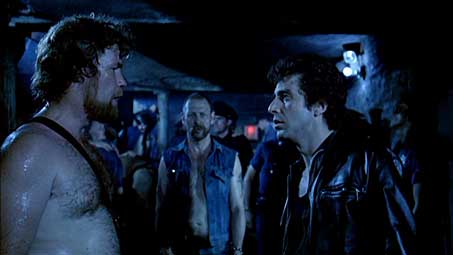 |
|
|
THE
FILM |
|
|
|
|
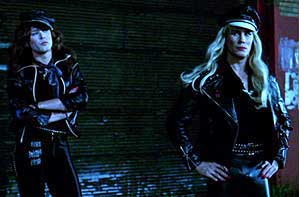 To
be quite frank, the film is a mess. Because we don't know the victims, there
is no suspense in any of the killings. When the film concentrates on the
cat and mouse game between Pacino and the killer in the third act, it loses
steam and often grinds to a halt. It is deliberately vague on many points
- a plus in foreign art films like L'Avventura or Blow-Up
but totally wrong for a police thriller. Friedkin suggests that there is
more than one killer, again fueling the flames that the gay lifestyle is
inheritantly violent. One of the most damning arguments to support this
is a series of subliminal shots - each lasting only a frame or two - of
gay pornography (close-ups of anal penetration to be exact) that flash on
the screen during the first murder scene - linking gay sex with the stabbing
of the knife. Cruising oozes
with queer self loathing. The killer tells each of his victims that "you
made me do that." The suspect that Pacino eventually pursues is a college
student who is writing a thesis on musical theatre and has an overbearing
father - all of the usual cliches. Pacino, too, has a dysfunctional relationship
with his father. Give Oedipus a rest. To
be quite frank, the film is a mess. Because we don't know the victims, there
is no suspense in any of the killings. When the film concentrates on the
cat and mouse game between Pacino and the killer in the third act, it loses
steam and often grinds to a halt. It is deliberately vague on many points
- a plus in foreign art films like L'Avventura or Blow-Up
but totally wrong for a police thriller. Friedkin suggests that there is
more than one killer, again fueling the flames that the gay lifestyle is
inheritantly violent. One of the most damning arguments to support this
is a series of subliminal shots - each lasting only a frame or two - of
gay pornography (close-ups of anal penetration to be exact) that flash on
the screen during the first murder scene - linking gay sex with the stabbing
of the knife. Cruising oozes
with queer self loathing. The killer tells each of his victims that "you
made me do that." The suspect that Pacino eventually pursues is a college
student who is writing a thesis on musical theatre and has an overbearing
father - all of the usual cliches. Pacino, too, has a dysfunctional relationship
with his father. Give Oedipus a rest. |
|
|
|
|
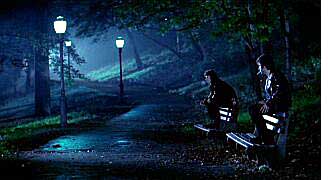 And
then we get to the implied premise that our lifestyle is not only violent
but contagious! Pacino is transformed by his exposure to the leather
world. We see this in his relationship with his girl friend, played by Karen
Allen. They are first seen together in bed making love gently while soft
chamber music plays on the stereo. The next time we see them together, he
is ramming her like a machine while he hears loud club music in his head.
Pacino grows more violent as the film goes on. Which brings us to the moment
that still angers many of us to this day: Spoiler alert! Skip the
next two paragraphs if you don't want to know how the film ends. And
then we get to the implied premise that our lifestyle is not only violent
but contagious! Pacino is transformed by his exposure to the leather
world. We see this in his relationship with his girl friend, played by Karen
Allen. They are first seen together in bed making love gently while soft
chamber music plays on the stereo. The next time we see them together, he
is ramming her like a machine while he hears loud club music in his head.
Pacino grows more violent as the film goes on. Which brings us to the moment
that still angers many of us to this day: Spoiler alert! Skip the
next two paragraphs if you don't want to know how the film ends. |
|
|
|
|
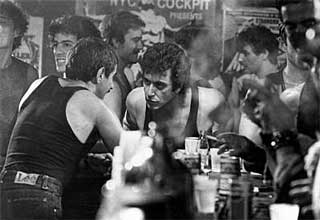 Call
me an old queer who is stuck in the past, but the premise that Pacino could
become a leather killer himself from his exposure to the scene is
homophobic to the core. Is he a killer? Who knows, but why even suggest
it? In Friedkin's defense, he only implies this. The book that Cruising
was based on did, in fact, end with the cop turning into a killer himself.
Friedkin may have toned this ugly theme down, but he also added the leather
bars which did not appear in the book. I'm sorry, but even if his
intentions were good, they were certainly misguided and it doesn't
get him off the hook. (Is it a coincidence that Friedkin also directed The
Boys in the Band ten years earlier - that paean to queer self loathing
that many today regard as a gay minstrel show?) Call
me an old queer who is stuck in the past, but the premise that Pacino could
become a leather killer himself from his exposure to the scene is
homophobic to the core. Is he a killer? Who knows, but why even suggest
it? In Friedkin's defense, he only implies this. The book that Cruising
was based on did, in fact, end with the cop turning into a killer himself.
Friedkin may have toned this ugly theme down, but he also added the leather
bars which did not appear in the book. I'm sorry, but even if his
intentions were good, they were certainly misguided and it doesn't
get him off the hook. (Is it a coincidence that Friedkin also directed The
Boys in the Band ten years earlier - that paean to queer self loathing
that many today regard as a gay minstrel show?) |
|
|
And now? |
|
|
|
|
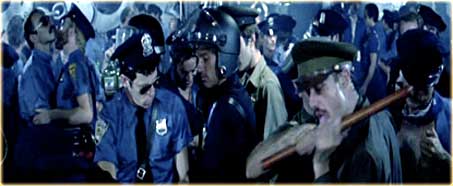 |
|
|
But, after the hormones wear off, even this documentary look is suspect. It has been enhanced. By the sheer nature of this being a performance many of the patrons may have acted out more for the cameras (I can't remember ever seeing a man fellate a billyclub on Leather Night at the old Buddies) and there is also, of course, the punk rock music in the background that was not the music of those clubs back then - giving the scenes a much more sinister feel than if Donna Summer was playing. But as hot as these scenes are, one gets uncomfortable in the realization of how shocking these images would have been to the general public in 1980. Hell, during one of the long camera pans we see a man in a sling about to be fisted! Okay, it was a gutsy scene for 1980, but do you honestly think that these images engendered warm and fuzzy feelings about gays from the audiences who first saw Cruising? To them, this was a freak show just like the orgy scenes were in Bob Guccione's dreadful Caligula the year before. To top it off, Ronald Reagan had just been elected President. The country was shifting to the Right. And in another year we would start hearing about AIDS. |
|
|
A note on the restored DVD: There are a few subtle differences between the film on the DVD and the one that played in movie theaters in 1980. There was no opening title in the original release; it began with a disclaimer that read: "This film is not intended as an indictment of the homosexual world. It is set in one small segment of that world which is not meant to be representative of the whole." This disclaimer is curiously missing now and a horizontal crawl of the film's title now slides by to reveal the opening shot. The scene where Al Pacino snorts poppers and dances is enhanced by a glow effect that lights up the entire bar as he inhales the drug. A review on DVDtalk.com claims that there is a short scene added near the end between the police and the killer's roommate but my memories can neither confirm or deny this.
More on William Friedkin:
Al Pacino also appears
in:
|